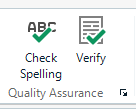Replying to Nora Díaz and for everybody else,
All you have to do is recreate the project, same resources, but with a different Target Language (most of the target segments will be populated automatically). After fiddling with different locales I arrived at the conclusion that for translations into Spanish, simply choose "Spanish (Spain, International Sort)" and don't bother with any other "varieties" of Spanish, and the "Check Spelling" will be there ready for you. However, you also have to change the target language of your Translation Memory. Export your Translation Memory to a TBX file, create a new memory with the new language choices, import that TBX you exported into the new memory and you're all set. Spanish is a very standard language across all countries in terms of spelling, with very, very few exceptions (so, no problem there) unlike American English versus British English.
On the other hand, there seems to be a problem choosing "Spanish (International)" in Studio 2015 and 2017, that I know of. It shows as "ES" (instead of a flag) and "Spanish (International)" in the list of languages. My advice, forget about it. In addition, both Studio versions assign to the translation project a non-standard locale code (es-x-int-SDL) that is non-existent as an ISO code and that could be the problem. Check this page for standard "language culture names" here: https://msdn.microsoft.com/en-us/library/ee825488(v=cs.20).aspx or Google it. For the solution that I propose, SDL Studio assigns, correctly, the language culture name es-ES, the one that does work. As a "bonus", both "Active Spell Checkers" (MS Word and Hunspell) will work (Go to Options / Editor / Spelling). Of course, that will depend on your MS Office settings (in my case I work exclusively in English, but in my "Office Language Preferences" I have Spanish, as well).

 Translate
Translate

